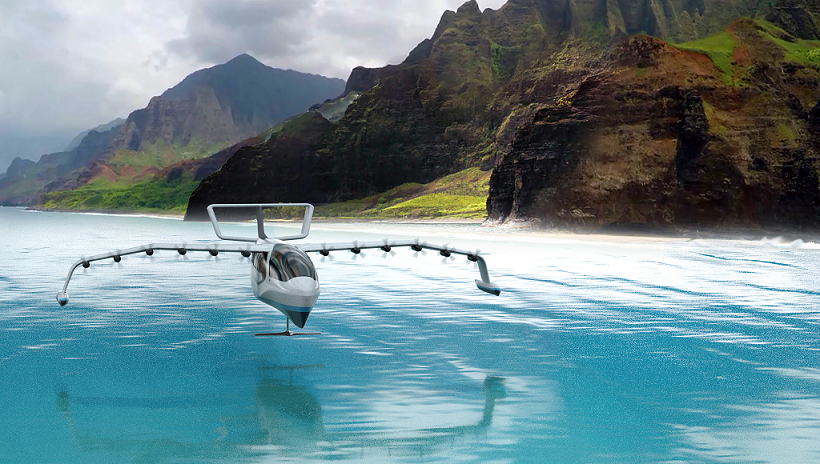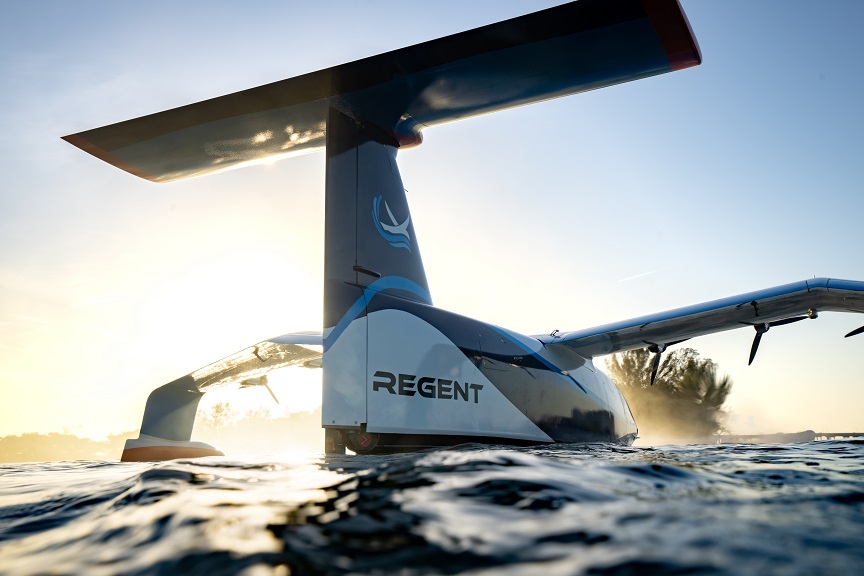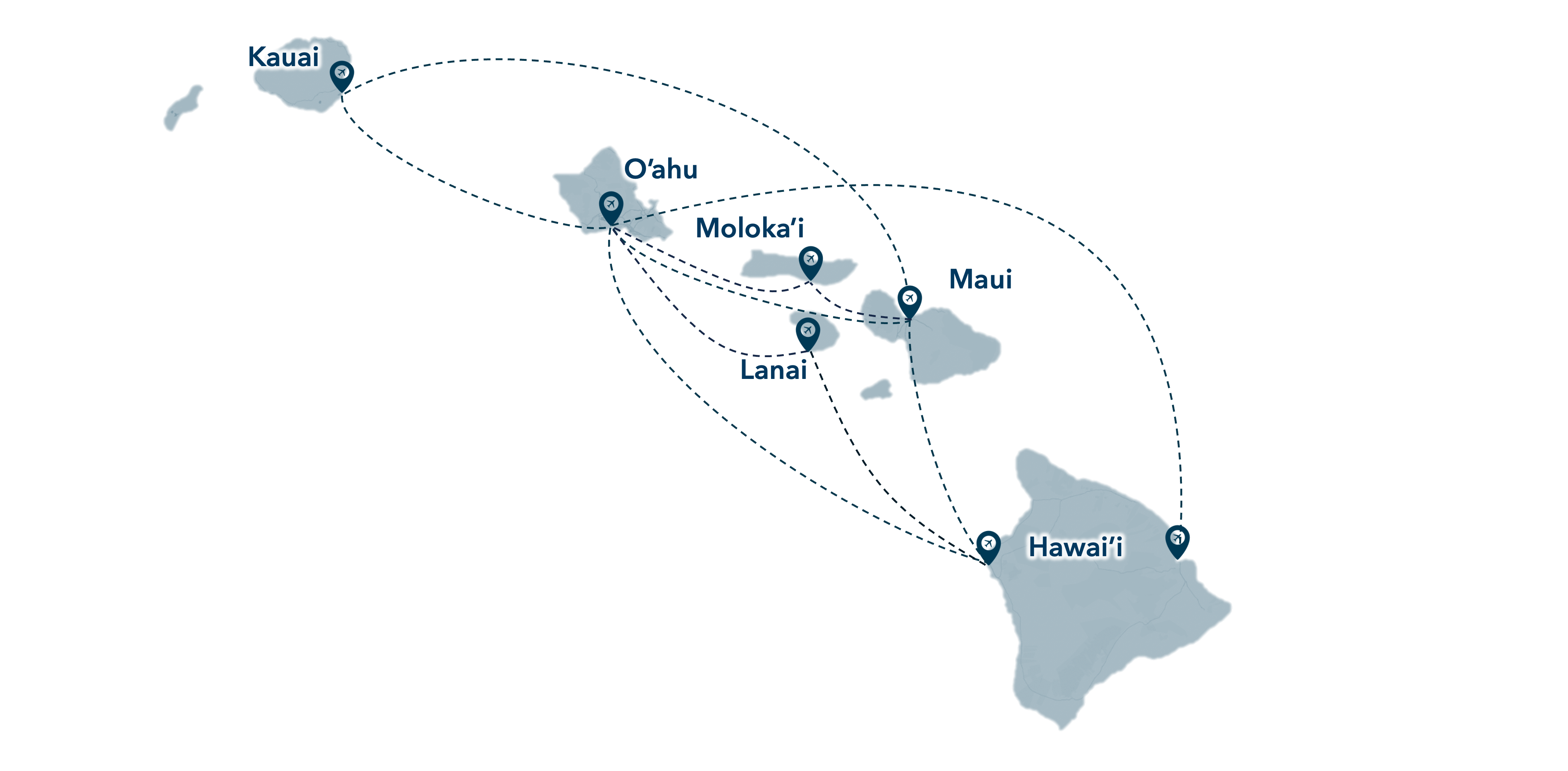
A New Approach to Travel Between the Islands
The Hawai'i Seaglider Initiative (HSI) is a consortium of local government, private sector, and community stakeholders working to increase awareness, understanding, and adoption of seagliders in Hawai'i with a focus on community, culture and environment.
Our mission is to understand and advocate for how seagliders can help Hawai'i modernize its maritime transportation network, enablement systems, and supporting renewable energy infrastructure in ways that create a more convenient and reliable transportation network for passenger and freight.
What is a Seaglider?
A seaglider is an all-electric, passenger-carrying, wing-in-ground-effect vehicle built to service coastal routes, building on real-world-proven tech.
Float. Foil. Fly!
Seagliders operate as nautical transport vessels that begin floating on a hull before transitioning to gliding on underwater hydrofoils and ultimately taking off to fly above the water's surface staying in ground effect.
-
Proven Technology
-
All-electric seagliders are possible due to tested aerodynamic principles and built to the highest safety standards.
-
Industry Leaders
-
Seagliders are brought to Hawai'i by world-class engineers in conjunction with local community leaders and organizations.
Powered By REGENT
REGENT's flagship seaglider, Viceroy, is a 12 passenger vehicle that operates exclusively over water traversing the sea in one of three modes: hull, hydrofoil, or flight in ground effect. Seagliders have 160 nautical mile range with existing battery technology (upgradeable to over 400 nautical mile range with next generation battery technology) and are expected to enter service by mid-decade. Full-scale prototypes will begin human sea trials by 2024.
-
Multi-Use
-
Seagliders can be adopted to fly both passengers and cargo.
-
All Electric
-
Seagliders are 100% electric with zero emissions.

Seagliders offer numerous benefits for Hawai'i
-
Good for Our Environment
-
Seagliders are 100% electric vehicles with zero emissions
-
Survey of Hawai’i residents show that many believe seagliders can help us meet the Hawai’i Clean Energy Initiative goals
-
Seagliders help address our state’s largest gap – clean air and maritime transportation
-
Affordable Travel
-
Preliminary feasibility study showed strong resident and visitor sentiment that the islands need more affordable passenger and cargo transportation
-
Seagliders have substantially lower operating costs and simpler infrastructure requirements compared with airplanes which translates to more affordable and accessible travel for residents
-
Unparalleled Convenience
-
With no TSA line and speeds of 180 miles per hour, seagliders offer faster and more efficient regional travel than boats and airplanes
-
Feasibility study results indicate a need and desire for Hawai’i to diversify its transportation system
-
Ports typically are more conveniently located than airports and play a central role in economic growth, specifically for isolated, island-based economies.
-
Emergency Care
-
Seagliders can be used as ambulances, transporting patients between the islands or transporting patients for routine follow-up treatment
-
Seagliders can be used for natural disaster preparedness and supply chain resiliency
-
Lower Cargo Costs
-
Preliminary survey indicates that many residents of Hawai’i residents believe that Hawai’i’s economy will benefit from a SEAGLIDER network due to increased efficiency and reduced cost of inter-island commerce
-
Bringing down transportation and supply chain costs between the islands will help bring down the price of goods, increasing the purchasing power of Hawai’i residents
-
Enable faster, more efficient and resilient movement of goods across the islands
-
Reducing the cost of the maritime supply chain
-
Reduction in the cost of shipping while increasing the purchasing power of residents for much needed commodities
-
Reducing the cost barrier for businesses to access greater markets and communities through connecting the inter-island economy
-
Through port development, SEAGLIDERS can support the socioeconomic well-being of its residents through direct and indirect employment opportunities and the maturation of maritime supply chains
-
Reduced Highway Traffic
-
Seaglider use for intra-island travel will reduce traffic congestion and make travel faster, easier, and less stressful
-
In a preliminary study, 30% of O’ahu residents indicated that they would be likely to use a commuter seaglider service regularly. On Hawai’i Island, 35% of residents support an intra-island route between Kona and Hilo
-
A Complete System
-
Seagliders enable more resilient transportation systems that can bounce back from disruptions
-
Seagliders charged with renewable energy will help decarbonize our islands
-
Linking To Underserved Communities
-
Expanding reliable access to available physicians and facilities, especially for remote communities
-
Utilizing reliable and affordable inter-island service to enable the engagement and support of Hawaiian cultural activities throughout the islands
-
Enabling the meeting of basic needs and building community cohesion
Frequently asked questions
-
Seagliders are all-electric wing-in-ground effect vehicles. Wing-in-ground effect refers to the airflow created by the vehicle's wings and surface of the ocean, which allows seagliders to travel smoothly above the water. This means seagliders can fly low (within one wingspan) over the water on a cushion of air to take advantage of numerous aerodynamic and operational efficiencies. Seagliders operate in three modes – float, foil and fly. From the dock, the vehicle first drives on its hull like a traditional boat. As it leaves the harbor area and speeds up, it rises on its hydrofoil, a key maritime technology popularized by America's Cup sailing competitions. The hydrofoil offers significant wave tolerance and a smooth ride as the seaglider leaves a harbor. Upon reaching open water, the seaglider takes flight, retracting the foil and accelerating up to cruise speed — all while staying within a wingspan of the water's surface.
-
No, seagliders use a different technology than the Hawai'i Superferry. Seagliders float, foil and fly to travel from one point to another. The Superferry used waterjet propulsion, cruising over the surface of the ocean. The Hawai'i Superferry operated without all of the necessary environmental impact statements. Although seagliders will be in the air for most of their travel time, there are still many studies that need to be conducted to understand any environmental impact on whales or other marine life and Hawai'i waters.
-
Seagliders fall under the jurisdiction of the U.S. Coast Guard and will be regulated to the highest safety standards for passenger carrying vehicles. In addition, seagliders will be certified by Bureau Veritas, a global classification society that provides third-party technical assessments and approves new seagoing vessels such as seagliders. REGENT has already received an Approval in Principle from Bureau Veritas, paving the way for commercial operations for its 12-passenger seaglider, Viceroy. In August 2022, REGENT successfully demonstrated the first seaglider flight with a quarter-scale prototype using remotely operated avionics and onboard flight control systems. Sea trials for its full-scale, human carrying prototype are expected to begin in 2024.
-
A preliminary survey of Hawai'i residents showed they are concerned that seagliders will only be affordable to the affluent and may result in an increased tax burden on Hawai'i's residents. The survey also showed that residents are concerned that seagliders may produce some form of ecological damage either near shore or in the areas surrounding the harbors. Others expressed their concern about how seagliders can potentially impact communities through an increase in visitors. All of these concerns are important to the Hawai'i Seaglider Initiative, and will be addressed as seagliders move forward in Hawai'i. We believe seagliders should bring the community together, not divide us. The goal of the Hawai'i Seaglider Initiative is to move forward with an open heart and mind as a unified community.
-
REGENT and Pacific Current commissioned SMS Research, a leading market research firm based in Honolulu, to look at the economic, environmental, and community benefits and challenges associated with introducing seagliders to Hawai'i. This initial survey examined the socioeconomic and technical feasibility of establishing an inter-island and intra-island seaglider system. The second phase of the feasibility study, led by EKNA Services, a Honolulu-based engineering and construction management firm, will include a detailed analysis of various ports and harbors. The data that we collect may also be incorporated into an environmental assessment or environmental impact statement.
-
SMS Research collected responses to questionnaires from mid-August 2022 until early October 2022 from government leaders, elected officials who would be direct decision-makers or appropriators for transportation services, maritime industry executives, and leaders from environmental and community organizations representing interests that would be directly impacted by the seaglider service. In addition, 844 randomly selected State of Hawai'i residents and 1,544 visitors were surveyed between August 30, 2022 and September 12, 2022. The visitors were qualified by indicating that they traveled for leisure by air, 500 miles or more, in the past five years and have visited Hawai'i in the past five years. Visitors were classified into either U.S. West (residents of the West Coast or Mountain states) or U.S. East (all other states except Hawai'i or the U.S. territories).
-
Seagliders are much less expensive to operate relative to airplanes. This cost reduction means much lower ticket prices than what are currently offered by airline while simultaneously providing a quicker door-to-door travel time.
-
We recognize the dangers of introducing a new mode of maritime transportation to Hawai'i's environment. This is why seagliders are built to the highest regulatory and environmental standards. Seagliders contain a suite of early detection and avoidance systems to ensure that birds, whales, and other marine life is kept safe. Seagliders also offer a zero-emission mode of fast and affordable travel. With transportation making up the majority of Hawai'i's energy emissions, seagliders represent a real and effective tool to help Hawai'i meet state sustainability goals which will further protect marine ecosystems.
Connecting Hawai'i
Seagliders will allow unparalleled connection between Hawai'i's historically underserved communities. With your input, we will ensure that the benefits of seagliders are felt throughout every island.
